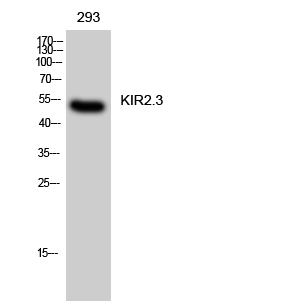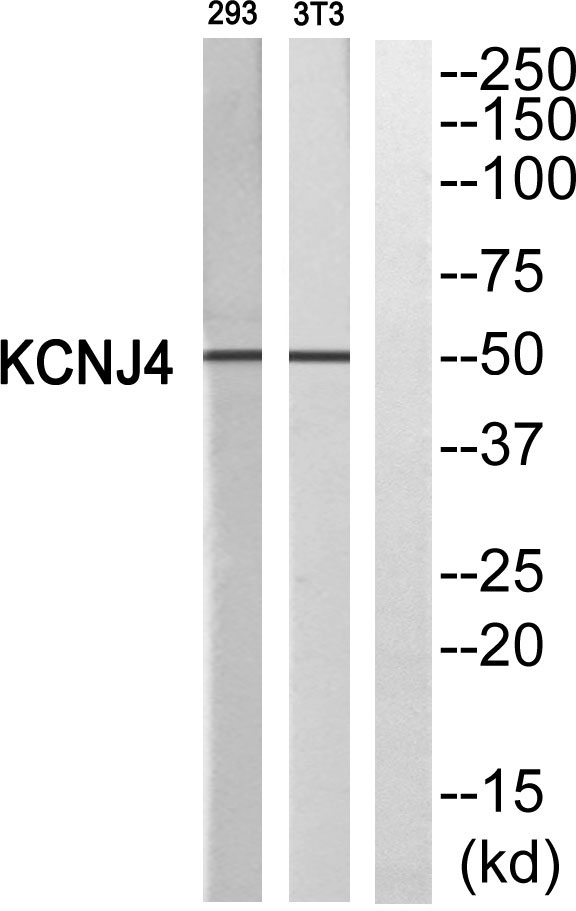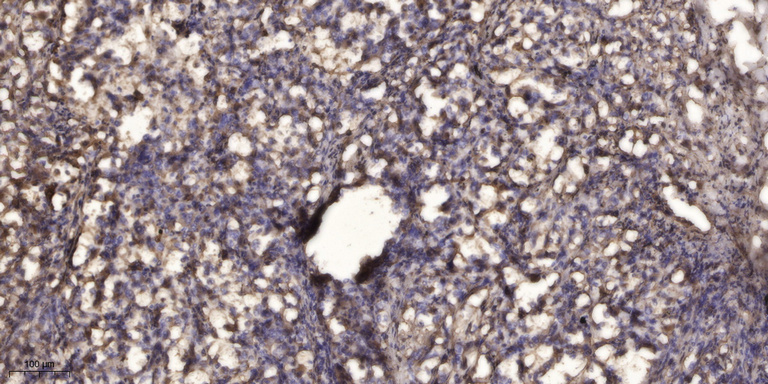KIR2.3 Polyclonal Antibody
- Catalog No.:YT2474
- Applications:WB;ELISA;IHC
- Reactivity:Human;Mouse;Rat
- Target:
- KIR2.3
- Fields:
- >>Cholinergic synapse;>>Oxytocin signaling pathway
- Gene Name:
- KCNJ4
- Protein Name:
- Inward rectifier potassium channel 4
- Human Gene Id:
- 3761
- Human Swiss Prot No:
- P48050
- Mouse Swiss Prot No:
- P52189
- Rat Gene Id:
- 116649
- Rat Swiss Prot No:
- P52190
- Immunogen:
- The antiserum was produced against synthesized peptide derived from human KCNJ4. AA range:251-300
- Specificity:
- KIR2.3 Polyclonal Antibody detects endogenous levels of KIR2.3 protein.
- Formulation:
- Liquid in PBS containing 50% glycerol, 0.5% BSA and 0.02% sodium azide.
- Source:
- Polyclonal, Rabbit,IgG
- Dilution:
- WB 1:500-2000;IHC 1:50-300; ELISA 2000-20000
- Purification:
- The antibody was affinity-purified from rabbit antiserum by affinity-chromatography using epitope-specific immunogen.
- Concentration:
- 1 mg/ml
- Storage Stability:
- -15°C to -25°C/1 year(Do not lower than -25°C)
- Other Name:
- KCNJ4;IRK3;Inward rectifier potassium channel 4;HIRK2;HRK1;Hippocampal inward rectifier;HIR;Inward rectifier K(+) channel Kir2.3;IRK-3;Potassium channel; inwardly rectifying subfamily J member 4
- Observed Band(KD):
- 50kD
- Background:
- Several different potassium channels are known to be involved with electrical signaling in the nervous system. One class is activated by depolarization whereas a second class is not. The latter are referred to as inwardly rectifying K+ channels, and they have a greater tendency to allow potassium to flow into the cell rather than out of it. This asymmetry in potassium ion conductance plays a key role in the excitability of muscle cells and neurons. The protein encoded by this gene is an integral membrane protein and member of the inward rectifier potassium channel family. The encoded protein has a small unitary conductance compared to other members of this protein family. Two transcript variants encoding the same protein have been found for this gene. [provided by RefSeq, Jul 2008],
- Function:
- domain:The Val/Gly/Ala/Pro stretch may have a functional role in the conductance or permeation properties.,function:This receptor is controlled by G proteins. Inward rectifier potassium channels are characterized by a greater tendency to allow potassium to flow into the cell rather than out of it. Their voltage dependence is regulated by the concentration of extracellular potassium; as external potassium is raised, the voltage range of the channel opening shifts to more positive voltages. The inward rectification is mainly due to the blockage of outward current by internal magnesium. Can be blocked by extracellular barium and cesium.,similarity:Belongs to the inward rectifier-type potassium channel family.,subunit:Homomultimeric and heteromultimeric association with Kir2.1, resulting in an enhanced G-protein-induced current. Association, via its PDZ-recognition domain, with LIN7A, LIN7B,
- Subcellular Location:
- Cell membrane; Multi-pass membrane protein. Cell junction, synapse, postsynaptic cell membrane ; Multi-pass membrane protein . Cytoplasmic vesicle membrane . TAX1BP3 binding promotes dissociation of KCNJ4 from LIN7 famaly members and KCNJ4 internalization. .
- Expression:
- Heart, skeletal muscle, and several different brain regions including the hippocampus.
- June 19-2018
- WESTERN IMMUNOBLOTTING PROTOCOL
- June 19-2018
- IMMUNOHISTOCHEMISTRY-PARAFFIN PROTOCOL
- June 19-2018
- IMMUNOFLUORESCENCE PROTOCOL
- September 08-2020
- FLOW-CYTOMEYRT-PROTOCOL
- May 20-2022
- Cell-Based ELISA│解您多样本WB检测之困扰
- July 13-2018
- CELL-BASED-ELISA-PROTOCOL-FOR-ACETYL-PROTEIN
- July 13-2018
- CELL-BASED-ELISA-PROTOCOL-FOR-PHOSPHO-PROTEIN
- July 13-2018
- Antibody-FAQs
- Products Images

- Western Blot analysis of 293 cells using KIR2.3 Polyclonal Antibody

- Western blot analysis of KCNJ4 Antibody. The lane on the right is blocked with the KCNJ4 peptide.

- Immunohistochemical analysis of paraffin-embedded human Squamous cell carcinoma of lung. 1, Antibody was diluted at 1:200(4° overnight). 2, Tris-EDTA,pH9.0 was used for antigen retrieval. 3,Secondary antibody was diluted at 1:200(room temperature, 45min).



